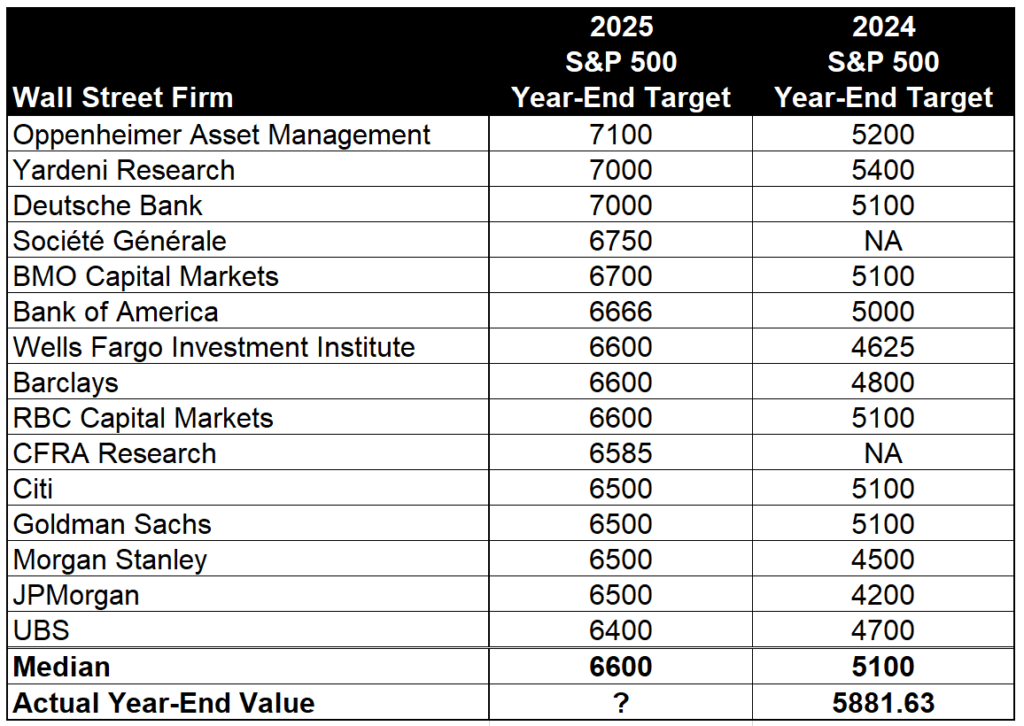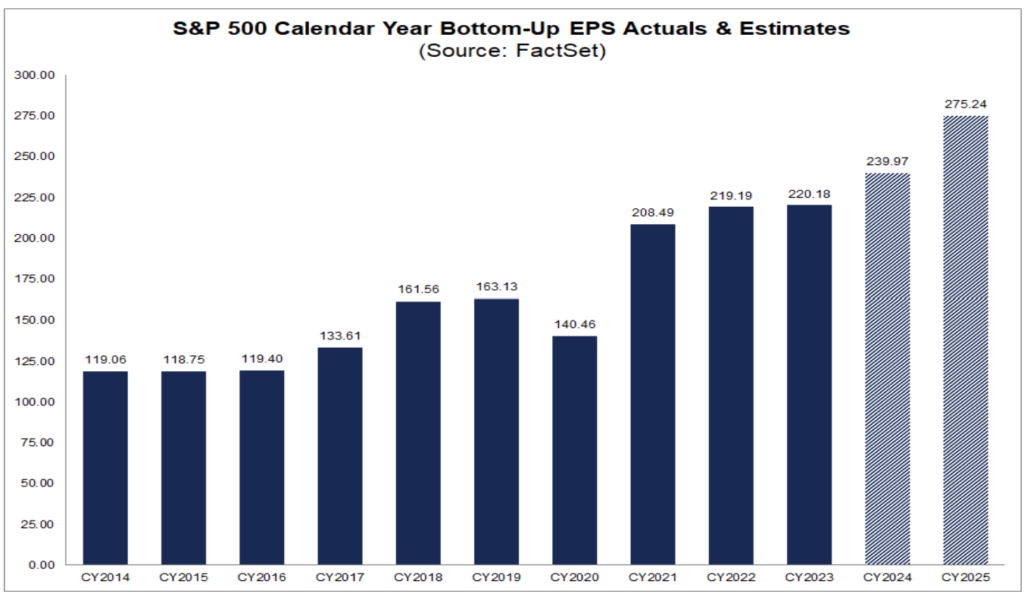Well, it’s that time of year again to take a look at Wall Street strategists’ year-end S&P 500 Index guesses (forecasts).
Without looking, how do you think they did?
For the record, I don’t envy the strategists’ job having to provide a price target for the S&P 500 Index, and I’m probably sure they don’t like to do it either. It doesn’t make much sense to try to provide a precise target on something so uncertain and driven by so many different, dynamic factors that are changing all the time.
What’s even worse, is that many investors rely on these short-term forecasts to make investment decisions, when instead, I believe they should be focusing on longer-term objectives.
So let’s take a look at those forecasts.
The S&P 500 Index started the beginning of 2024 at 4769.83 and ended the year at 5881.63. This resulted in an actual price increase of 23% for 2024. Add in some dividends and the S&P 500 index had a total return of 25% for the year.
In the table of Wall Street strategists’ forecasts below, it shows that at the beginning of 2024, the median price target forecast for the S&P 500 Index was 5100, less than the actual year-end value for the index. Using the S&P 500 Index beginning of the year value of 4769.83, the median forecasted strategists’ return for the Index was 6.9%. This is clearly less than the actual 23% price return of the Index for the year. Oops.

Based on these numbers, Wall Street strategists’ original median return forecast was 16% lower than the actual return for the S&P 500 Index. Some firm strategists were closer to the year-end target and some were much lower.
Not one Wall Street firm strategist’s original forecast was higher than the actual year-end value. Only after the market started rallying strongly to start 2024 did strategists start to raise their forecasts. Again, it seems to be yet another year of strategists’ chasing the market higher.
Chasing the Market Higher in 2024
You can read about my frustration last year about strategists raising their forecasts after the market rallied here: Market Rallies ->Strategists Raise Forecasts May 21, 2024
Just imagine if you were an investor relying on the strategists’ original 2024 forecasts to position your investments, like you are probably doing now for this year. If the S&P 500 Index was already relatively close to those strategists’ year-end targets, you may have wanted to start the year a bit more defensive. Based on the strategists’ forecasts, you may have believed the upside return appeared to be somewhat limited for 2024.
As the year progressed in Q1 and Q2 last year, the market rallied significantly. Think about how the strategists’ felt when the S&P 500 was already way above their year-end price targets. Career risk is a real risk for these strategists’ so I’m sure they felt pressured to raise their forecasts. Now think about how investors relying on those forecasts felt. Think about those that were defensively positioned as they watched the market rally higher and potentially getting away from them.
With strategists’ year end forecasts way behind the price of the S&P 500 Index at the time, the strategists started raising their forecasts higher to catch up (Market Rallies ->Strategists Raise Forecasts May 21, 2024). Investors that were following the strategists’ forecasts also may have felt stuck in their defensive positioning and emotionally felt the need to chase the market higher as well. Welcome to FOMO: Fear of Missing Out
As strategists appeared to be “forced” to raise forecasts and investors may have emotionally “felt” the need to increase equity risk exposure, this became a feedback loop. This resulted in strategists and investors continuing to chase the market from behind and the market continued to grind higher.
This was a great example of FOMO, herd-mentality, trend-following and momentum.
Wall Street Strategists’ S&P 500 Index Target
In the table above, you can see the Wall Street strategists’ median S&P 500 Index 2025 year-end price target is 6600. This is a forecasted price increase of 12% from 2024. As it has been in the past, the spread of forecasts is wide this year, ranging from 7100 on the high side (+20.7% price increase) to 6400 (+8.8%) on the low side.
With such a wide dispersion in forecasts, you have to ask yourself: If all of these firms have access to similar data and a bunch of smart people, why are the forecasts all over the place?
My Answer: Because they are just guesses and they shouldn’t be considered with any confidence or precision. Any one of the Wall Street forecasts could be correct, or like in 2024, not even close to being correct.
Calculate Your Own 2025 S&P 500 Index Target
I wrote about how I think about potential price targets for the S&P 500 Index in my Outlook and Positioning piece on December 11, 2024. I’ll reiterate it here…
If you want to get a target for the S&P 500 for next year, you can listen to the Wall Street strategists, who are often forced to come up with a target for their job…..aaaannndddd……then they change the target throughout the year as the market moves expecting you to catch up after the move has happened.
Or…
Instead of or in addition to the Wall Street strategists, you can just take the 2025 estimated $275 earnings forecast for the S&P 500 Index from FactSet (shown below), put a 12-month trailing P/E (price-to-earnings) range on it, say 24x on the mid-to-high end and 17x on the mid-to-low end, and do some calculations. That can give you a range on the S&P 500 Index that you could consider “normal”.
So for me, I’ll take the $275, then reduce it by 10% to get to $247.50 to try to be a little conservative. I’ll use a 17x P/E for the downside (again to be a little conservative) and multiply to get: $247.50 x 17 = 4207 on the S&P 500 Index for a potential downside target. If we use the upper P/E ratio of 24x, then $247.50 x 24 gets you to 5940, which is about right where we are now. That signals to me we could have some sort of pullback next year in the S&P 500 Index and it would be completely normal.
If we want to measure a potential bullish market on the numbers, and EPS is 10% higher than the $275 estimate at $302.50, then using the 17x and 24x P/E multiples, we can get to a range of 5142 and 7260 on the S&P 500 Index, respectively.
So for my targets, based on the calculates above, I’ll use a bearish target of 4200 on the low end and 7300 on the high end, with the understanding that anything can happen for any reason. I’ll just use these levels and let the market come to me, making adjustments accordingly.

Over-Reliance on False Confidence
I think these “forecasts” create an over-reliance on false confidence. I think the strategists’ probably know these initial forecasts could end up way off the mark and they probably don’t like doing it. They just know they need to generate year-end targets because every other firm is doing it and clients are demanding something.
Strategists often find themselves putting out a year-end target, then adjust throughout the year as the market moves for whatever reasons (fundamentals, technicals, etc.). What was bothersome to me last year, is that the strategists’ originally put out targets to start the year, then as the market rallied, they raised their forecasts. It’s like the market’s movements drive the strategists’ forecasts, rather than the strategists’ correctly determining the future fundamentals and technicals that will ultimately impact the markets price.
I’ve written about my annoyance of Wall Street strategists’ forecasts in the past. You can see my notes in the articles below…
- Wall Street Strategists’ Guesses for 2024 January 14, 2024
- Wall Street Strategists’ 2023 Forecast Review – Ouch! January 9, 2024
- Wall Street Strategists’ 2023 Outlook (Guess) January 15, 2023
Summary
In summary, take the Wall Street strategists’ or any else’s forecasts, including mine, with caution. Anything can happen at any point and impact the fundamentals, market sentiment and market technicals, causing upside or downside in the financial markets.
I’ll personally review the forecasts to get a general sense of the bullishness/bearishness of other investors. If the forecasts are pretty bullish, I’ll generally assume that the firms are already positioned bullish and could be a source of downside volatility because this bullish positioning could turn bearish at any time. If the forecasts are cautious or bearish, I’ll generally assume there is a potential for assets sitting on the sidelines that could be put to work, as investors buy the dips and put a bit of a floor under the market.
As I’ve stated before, I don’t try to make big market predictions. Instead, I try to let the market come to me and make adjustments accordingly.
I’ll continue to do that in 2025.
